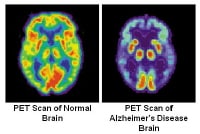Essential update: Memory tests plus brain imaging help detect early, asymptomatic AD
A study of 129 cognitively normal adults aged 65-87 years (mean, 73.7 years), presented at the Alzheimer's Association International Conference (AAIC) 2013, indicated that a combination of memory tests and brain imaging may help identify the earliest stages of AD before symptoms appear.[1] In this study, poor episodic memory in the context of synaptic dysfunction and elevated amyloid identified subjects who were at high risk for progression to AD dementia.Study subjects underwent testing of memory and executive function along with fluorine-18 fluorodeoxyglucose positron emission tomography (FDG-PET) and amyloid deposition with C 11 Pittsburgh Compound B (PiB PET).[1] The researchers found that amyloid burden and synaptic dysfunction independently predicted episodic memory performance. Subjects with worse memory performance had higher PiB deposition and lower FDG metabolism in regions of the brain commonly affected in AD.
Some individuals had worse memory scores and lower FDG metabolism (synaptic dysfunction) but a normal PiB scan (no amyloid deposition), which indicated that not all memory changes were a result of amyloid plaques.[1] Individuals who performed worse on nonmemory executive function tests also had lower FDG metabolism but a normal PiB scan. More highly educated individuals had normal performance on memory tests despite lower FDG metabolism and higher PiB retention.
Signs and symptoms
Preclinical Alzheimer diseaseA patient with preclinical AD may appear completely normal on physical examination and mental status testing. Specific regions of the brain (eg, entorhinal cortex, hippocampus) probably begin to be affected 10-20 years before any visible symptoms appear.
Mild Alzheimer disease
Signs of mild AD can include the following:
- Memory loss
- Confusion about the location of familiar places
- Taking longer to accomplish normal, daily tasks
- Trouble handling money and paying bills
- Compromised judgment, often leading to bad decisions
- Loss of spontaneity and sense of initiative
- Mood and personality changes; increased anxiety
The symptoms of this stage can include the following:
- Increasing memory loss and confusion
- Shortened attention span
- Problems recognizing friends and family members
- Difficulty with language; problems with reading, writing, working with numbers
- Difficulty organizing thoughts and thinking logically
- Inability to learn new things or to cope with new or unexpected situations
- Restlessness, agitation, anxiety, tearfulness, wandering, especially in the late afternoon or at night
- Repetitive statements or movement; occasional muscle twitches
- Hallucinations, delusions, suspiciousness or paranoia, irritability
- Loss of impulse control: Shown through behavior such as undressing at inappropriate times or places or vulgar language
- Perceptual-motor problems: Such as trouble getting out of a chair or setting the table
Patients with severe AD cannot recognize family or loved ones and cannot communicate in any way. They are completely dependent on others for care, and all sense of self seems to vanish.
Other symptoms of severe AD can include the following:
- Weight loss
- Seizures, skin infections, difficulty swallowing
- Groaning, moaning, or grunting
- Increased sleeping
- Lack of bladder and bowel control
See Clinical Presentation for more detail.
Diagnosis
Means of diagnosing AD include the following:- Clinical examination: The clinical diagnosis of AD is usually made during the mild stage of the disease, using the above-listed signs
- Lumbar puncture: levels of tau and phosphorylated tau in the cerebrospinal fluid are often elevated in AD, whereas amyloid levels are usually low; at present, however, routine measurement of CSF tau and amyloid is not recommended except in research settings
- Imaging studies: Imaging studies are particularly important for ruling out potentially treatable causes of progressive cognitive decline, such as chronic subdural hematoma or normal-pressure hydrocephalus[2]
Management
All drugs approved by the US Food and Drug Administration (FDA) for the treatment of AD are symptomatic therapies that modulate neurotransmitters, either acetylcholine or glutamate. The standard medical treatment for AD includes cholinesterase inhibitors (ChEIs) and a partial N-methyl-D-aspartate (NMDA) antagonist.[3, 4]The following classes of psychotropic medications have been used to treat the secondary symptoms of AD, such as depression, agitation, aggression, hallucinations, delusions, and sleep disorders[5] :
- Antidepressants
- Anxiolytics
- Antiparkinsonian agents
- Beta-blockers
- Antiepileptic drugs: For their effects on behavior
- Neuroleptics
There are no proven modalities for preventing AD,[3] but evidence, largely epidemiologic, suggests that healthy lifestyles can reduce the risk of developing the disease; the following may be protective[6, 7] :
- Physical activity
- Exercise
- Cardiorespiratory fitness
- Diet: Although no definitive dietary recommendations can be made, in general, nutritional patterns that appear beneficial for AD prevention fit the Mediterranean diet
Image library

Sem comentários:
Enviar um comentário
Gostou do meu Blog? Envie a sua opinião para lmbgouveia@gmail.com